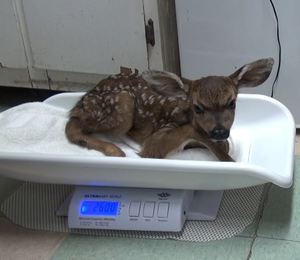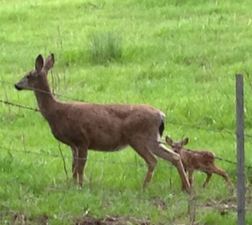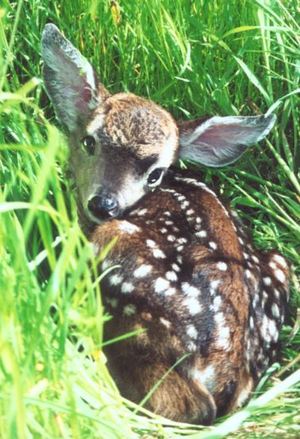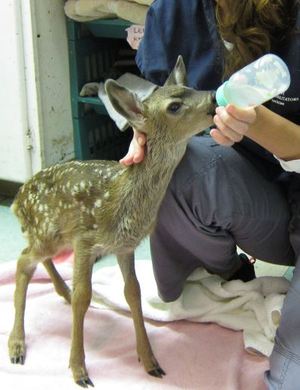Tips from WildCare Will Help You Decide When a Fawn Needs to be Rescued, and When It Doesn't!
 Every year WildCare's Wildlife Hospital admits approximately 40 Black-tailed Deer fawns. This spotted baby, Patient #227, came to WildCare from the town of Berkeley, California, where she was found trapped under a parked car.
Every year WildCare's Wildlife Hospital admits approximately 40 Black-tailed Deer fawns. This spotted baby, Patient #227, came to WildCare from the town of Berkeley, California, where she was found trapped under a parked car.
Like this little patient, many of the fawns we admit are injured or orphaned and desperately need our care.
But every year we also see healthy fawns that have been "rescued" by well-meaning people who mistakenly think that the young deer have been abandoned. Many of these babies can be successfully reunited with their mothers if a medical exam proves them to be healthy and well-cared for, but the experience is still stressful for the deer.
 With fawn season upon us, WildCare would like to alert the public to when a fawn needs human intervention and when a healthy fawn should be left alone because mom is nearby, even if she can't be seen.
With fawn season upon us, WildCare would like to alert the public to when a fawn needs human intervention and when a healthy fawn should be left alone because mom is nearby, even if she can't be seen.
"It is incredibly important for people to understand that deer are very good mothers and do not abandon their young," says Melanie Piazza, Director of Animal Care at WildCare. "In order to keep her young safe, a doe will leave her fawn in a grassy area, often for as long as 12 hours, distracting predators away from her baby while she forages for food. Also, it is not true that human scent on a wild animal will cause the mother to abandon her baby."
 Fawns' camouflage and their ability to stay still keep them safe from predators while their mother is away. When approached by a perceived predator (humans, pets or wildlife) a fawn's automatic instinctual response is to lay very low and not move at all. People often mistake this defensive behavior for injury, weakness or illness.
Fawns' camouflage and their ability to stay still keep them safe from predators while their mother is away. When approached by a perceived predator (humans, pets or wildlife) a fawn's automatic instinctual response is to lay very low and not move at all. People often mistake this defensive behavior for injury, weakness or illness.
There is nothing more charming than a fawn, which makes anyone lucky enough to come across one eager to "help." But it is imperative to know when help is truly needed.
Fawns are incredibly high stress and their care is very labor-intensive. Stacey Johnson, WildCare's volunteer Fawn Foster Care Specialist, cares for dozens of fawns every baby season, and each fawn is in her care for four months or more. WildCare spends many hours reuniting kidnapped fawns with their mothers in an effort to keep young where they belong (with their moms) and to save WildCare's resources and Johnson's specialized care for those fawns that truly do need medical attention.
The goal our outreach efforts is to prevent healthy fawns from being unnecessarily "rescued" in the first place, saving everyone involved, especially the deer, a lot of time and stress.
So how do you know when a fawn truly needs help? The "5 Cs" were developed to help answer that question.
 The 5 Cs
The 5 Cs
Ask yourself:
1. Is the fawn crying?
2. Is the fawn cold?
3. Is the fawn coming toward you (approaching humans)?
4. Is the fawn covered in blood or insects?
5. Has the fawn been caught by a dog or cat or other animal?
If you answered yes to any of the 5 Cs, contact your local wildlife center immediately (click for a list of wildlife rescue centers by state)! That fawn needs immediate help!
If the answers are no, keep going--Mom will re-emerge when no people are around. And when she does, she will be happy to find her fawn waiting for her.
WildCare is a 501(c)3 nonprofit organization supported almost entirely by private donations and individual memberships. Visit us online at wildcarebayarea.org.
Support HuffPost
Our 2024 Coverage Needs You
Your Loyalty Means The World To Us
At HuffPost, we believe that everyone needs high-quality journalism, but we understand that not everyone can afford to pay for expensive news subscriptions. That is why we are committed to providing deeply reported, carefully fact-checked news that is freely accessible to everyone.
Whether you come to HuffPost for updates on the 2024 presidential race, hard-hitting investigations into critical issues facing our country today, or trending stories that make you laugh, we appreciate you. The truth is, news costs money to produce, and we are proud that we have never put our stories behind an expensive paywall.
Would you join us to help keep our stories free for all? Your contribution of as little as $2 will go a long way.
Can't afford to donate? Support HuffPost by creating a free account and log in while you read.
As Americans head to the polls in 2024, the very future of our country is at stake. At HuffPost, we believe that a free press is critical to creating well-informed voters. That's why our journalism is free for everyone, even though other newsrooms retreat behind expensive paywalls.
Our journalists will continue to cover the twists and turns during this historic presidential election. With your help, we'll bring you hard-hitting investigations, well-researched analysis and timely takes you can't find elsewhere. Reporting in this current political climate is a responsibility we do not take lightly, and we thank you for your support.
Contribute as little as $2 to keep our news free for all.
Can't afford to donate? Support HuffPost by creating a free account and log in while you read.
Dear HuffPost Reader
Thank you for your past contribution to HuffPost. We are sincerely grateful for readers like you who help us ensure that we can keep our journalism free for everyone.
The stakes are high this year, and our 2024 coverage could use continued support. Would you consider becoming a regular HuffPost contributor?
Dear HuffPost Reader
Thank you for your past contribution to HuffPost. We are sincerely grateful for readers like you who help us ensure that we can keep our journalism free for everyone.
The stakes are high this year, and our 2024 coverage could use continued support. If circumstances have changed since you last contributed, we hope you’ll consider contributing to HuffPost once more.
Already contributed? Log in to hide these messages.




